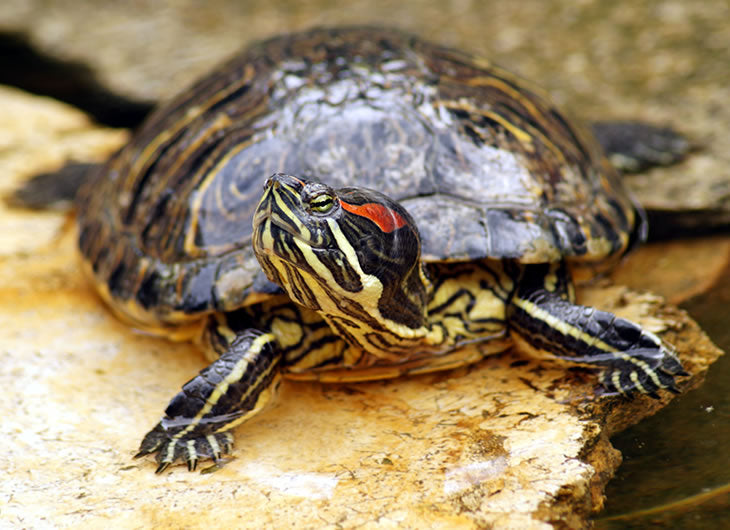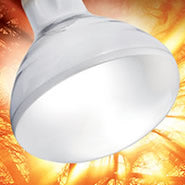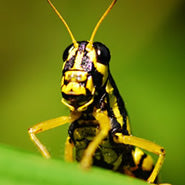Free Delivery
On order over £79*



Housing: a turtle terrarium of at least 90-120cm in length

Heating: basking temperature of 100oF and intense UVB

Water Maintenance:temperature of 80oF and a strong filter

Diet: carnivorous mix of shrimp, meat and insects

Decoration: basking platform with a ramp

Red-eared terrapin require a glass turtle tank as their enclosure. This is because they will need fully submerged sections without risk of warping or leaking. The red-eared terrapin can grow to 200mm (8'') long and needs a proportional amount of space to live happily. For this reason we suggest a tank with at least 900-1200mm in width.
The tank should also be tall enough to provide areas for the turtle to swim so we suggest a minimum height of around 300mm. A ramp and dock should be used to ensure the turtle has a space to get out of the water and bask.
As juveniles the red-eared terrapin can be kept in a 900mm enclosure but this will have to be upgraded as they grow. There are no detremental effects for having them in the enclosure for life straight away so we usually suggest you start with the full set up.
During the day the turtle will periodically move on to the basking area. This allows the turtle to dry off, warm up, absorb UVB and rest. A good basking spot should be around 80oF and provide sufficient UV. All Turtles require additional UVB lighting. Red-eared terrapins require UVB light in order to synthesise vitamin D. Without vitamin D (in particular D3) the turtle will not be able to metabolise calcium properly causing problems with bone growth.
A spot light and UV tube can be used over the basking area of the turtle. Either a 60w or 100w basking bulb should be sufficient depending on temperatures achieved. A 12% intense UV tube (either T5 or T8) can be used to provide the intense UV. Alternatively a sigle mercury vapour bulb can be used to provide both heat and UV. This bulb should be placed 30cm or closer and will need a porcelain or ceramic lamp holder.
Red-eared terrapins spend most of their time in the water so keeping it warm and clean is a priority. These turtles can be quite messy due to their high protein diet so require quite a strong filter to keep them clean. If you have a powerful filter you should only need to check it once a fortnight and clean the entire enclosure once every 3 months or so.
Water should always be treated before being introduced to the turtles enclosure to remove the chlorine. If you do not do this trace elements in the tap water can disturb the biological pads in your filter and even effect your pet.
A contant temperature of 25oC (75-80oF) should be maintained day and night. A water heater can be used to keep the water warm. A general guide to go by is 1W will warm 1L of water. In large enclosure (over 3ft wide) it is worth considering getting 2 half strength water heaters and placing one at each end to ensure an even temperature.
The most important decoration in a turtle enclosure is the basking area. It should be large enough to fit the turtle with some room to turn. The basking area should always be in line with the water level to ensure that your turtle can get out easily, there are floating docks available that will reposition to match the water level. A good basking area will also include a ramp for the turtle to make it easier to climb.
Artificial plants are a great way to provide cover under water and add colour to the enclosure. Those with weighted bottoms can be fully submerged whilst light plastic decorations can be left to float on top. Giving the turtles partial cover and a mixture of weighted and floating decorations provide great enrichment and help the turtle feel secure.
Large pebbles, coated gravel or riverbed sand can be used to line the bottom of the enclosure. It is adviseable to clean any substrate before placing it into the enclosure. The substrate should be left to settle before the euipment is turned back on and the turtles are put in.
The red-eared terrapins will eat a range of aquatic foods, meat products and livefood. They can also be fed dried foods when the fresh or live options are not available. The dried food should be created with shrimp or meat protien rather than vegetation.
We have found that brown crickets are the most readily accepted, but you can also use black crickets, dubia cockroaches or locusts (hoppers). shrimp, salmon, mice and chicks can also be fed for the meat portion of the turtles diet.
If you keep a male and female together, they may breed. You do not need to do anything to encourage this, providing they are healthy and the conditions are good, it will happen naturally. You need to consider whether you want this to happen. What will you do with the babies if you incubate the eggs?
A gravid female should have access to a nesting box to lay her eggs. The box should be large enough that she can fully turn-around and deep enough to dig in to. We use a soil mix in there that is wet enough to clump but no more. We have found that Spider Life substrate is ideal.
The eggs should be incubated in an incubator at 84oF. We incubate our eggs in sealed boxes on a moisture rich substrate (such as Hatchrite) to trap the humidity around the eggs. After approximately 60 days the eggs will start to hatch, the first babies to emerge will encourage the rest of the eggs to hatch.
Sign up to the Reptile Centre newsletter so you don't miss out on all the latest offers and guides to give your pet the best they deserve







